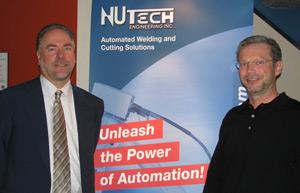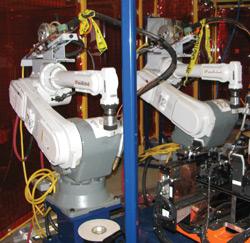- FMA
- The Fabricator
- FABTECH
- Canadian Metalworking
NuTech Engineering
Ontario integrator brings automation to the welding industry
Given the continuing exodus of work to countries with low labor costs, Canadian Manufacturing 101 teaches us that using automation to increase throughput will help keep the final cost of a part low. Also fewer manual handlings can help preserve the best part quality.
At NuTech Engineering, Milton, Ont., automating a welding process can mean anything from creating a one-robot cell to a line with dozens of welding robots, custom fixturing, and material handling systems.
What this means to the welding industry is the ability to create complex parts and assemblies with multiple welding operations in less time and with better quality than is possible through a manual process.
Throw into the mix a shortage of welders, and the table is set for automation.
Auto Sector Understands Automation
When NuTech Engineering opened in 1988, the company supported other integrators by doing small, overflow work.
“In those early days the company was very diverse in terms of the different industry sectors it served,” explained Gord Attridge, vice president of sales and marketing. “It’s that type of diversification that we are aiming at again.”
In the mid- to late ’90s the company’s varied customer base gave way to the juggernaut that is the automotive sector. Lured into the auto sector because of the ease in which jobs could be won, NuTech experienced growth but also became reliant on one industry.
“We were good at what we were doing, and the company grew pretty dramatically,” said Attridge. “In the years between 2001 and 2005 we became 100 percent automotive driven. That industry really understands and accepts automation because of its productivity, quality, and repeatability. If you are going to weld something in the automotive industry, you are going to use a robot.”
Then in 2005 NuTech started seeing a slowing of the domestic automotive industry as Toyota, Nissan, and Honda started to really compete with the Detroit Three.
Also at this time, the number of integrators vying for automotive work increased.
“In 2005 we saw the writing on the wall, and decided we wanted to reduce our dependence on the automotive sector,” he said. “That’s when we identified some key markets that could use our expertise.”
Transferring a knowledge base and lessons learned from automating the automotive supply chain to other domestic and global supply chains is how the company plans to diversify, grow, and recession-proof itself.
“We specialize in the automation of welding processes. But this expertise also opens up other opportunities with new customers,” he said.
New Markets, Same Knowledge
Some market segments that NuTech has identified as having potential include the aerospace, energy, construction, agriculture, and rail sectors. The company predicts that each of these sectors can benefit from one or more of the manufacturing advantages realized from automation, while at the same time reducing NuTech’s dependence on the automotive marketplace.
Using automation to increase throughput and improve quality may seem simple enough, but there are definite hurdles to overcome before any implementation can be accomplished.
In welding for the nuclear industry, for example, weld procedures often date from the 1970s.
“This is a prime example of an industry that is not taking advantage of welding automation in a major way,” said Attridge.
Not only can the nuclear segment of the energy sector be a potential growth area for NuTech, but so, too, can “green” energy. Wind power generation and solar energy systems all have requirements for welded components.
“Solar energy collection and distribution systems can be very weld intensive. You need to have low-distortion, high-quality welds to produce these systems,” he said.
Infrastructure creation, such as bridge building, also is a target for welding automation, but it is a difficult industry segment to enter. This is a market that will remain strong domestically because of the stationary nature of the builds and ongoing maintenance requirements. It is just not economical or practical to build infrastructure anywhere other than where it is needed.

Creating material handling chutes is only one aspect of cell design that is moved to NuTech's manufacturing floor.
“We need a system for automation in this sector that will provide an upgrade in weld quality and speed but remain familiar to those doing the work,” he said. “This will improve the quality of the work being done but will not scare off those welders that are unfamiliar with automated welding technology.”
Another major hurdle for manufacturing is the lack of qualified welders in this country these days. As the average age of an experienced welder increases there are fewer and fewer resources available to do the work. Welding automation gives manufacturers a way to spread the knowledge of a highly-skilled welder over a variety of applications, reducing their dependence on people with hard to find skill sets.
“We haven’t mined all of the opportunities for automation in this country yet,” said Attridge. “If we reduce the nonvalue-added labor content in a part or assembly through the use of automation, we can save manufacturing jobs, not eliminate them.”
Laser Welding
One area of welding technology that is responsible for growth at the company is its use of laser welding processes.
“Laser welding is the sharp point of our spear,” explained Attridge. “It’s what got us into the aerospace sector and keeps us there.”
According to Attridge, laser welding is one application that is suitable for virtually every industry because of its ability to weld at high speeds. Laser welding also creates low heat input, which creates a small heat-affected zone (HAZ) and welds with minimal distortion to the material.
The company has taken the expertise it developed in laser welding for the aerospace industry and now is transferring it to other industries.
“We have been introducing laser welding recently to the auto sector,” he said. “What will make it successful in the auto sector is the speed. With laser welding you can weld a joint up to three times faster than with traditional processes and still get the penetration and quality that you need.”
Laser welding even can be used for welding thicker materials with the needed penetration. With gas metal arc welding (GMAW), for example, you will not get the same penetration or speed. The laser, when combined with GMAW, can do it much faster, reaching speeds of more than 1 m per minute in some applications. Also, taking out the human element can eliminate errors and weld quality problems.
There also is a potential consumable cost advantage because less filler material is used when you reduce or eliminate the need for the extensive joint preparations required for GMAW.
Automation Challenge
One of the biggest challenges in the creation of a custom automation cell comes in the form of material handling. Getting material in, moving semifinished parts through the cell, and ejecting the finished parts often creates the biggest headaches.
“The creative part of cell design is how to get material in and parts out of the cell and creating the correct fixture concepts,” said Attridge. “This is driven from the applications department. Our application specialists need to understand not only the requirements of the cell that they are designing but also what is outside the cell.”
Geographic Diversity
In addition to market diversification, NuTech also is focused on geographic diversification. Even as far back as 2001, the company began to focus on global jobs by partnering with other integration companies around the world.
This enabled NuTech to win programs that normally would have been secured by larger, global integrators. By partnering with European-based companies, NuTech is able to pool resources and compete effectively on the world stage.
For more information, visit www.nutech-engineering.com.
subscribe now


Keep up to date with the latest news, events, and technology for all things metal from our pair of monthly magazines written specifically for Canadian manufacturers!
Start Your Free Subscription- Trending Articles
- Industry Events
MME Winnipeg
- April 30, 2024
- Winnipeg, ON Canada
CTMA Economic Uncertainty: Helping You Navigate Windsor Seminar
- April 30, 2024
- Windsor, ON Canada
CTMA Economic Uncertainty: Helping You Navigate Kitchener Seminar
- May 2, 2024
- Kitchener, ON Canada
Automate 2024
- May 6 - 9, 2024
- Chicago, IL
ANCA Open House
- May 7 - 8, 2024
- Wixom, MI

















